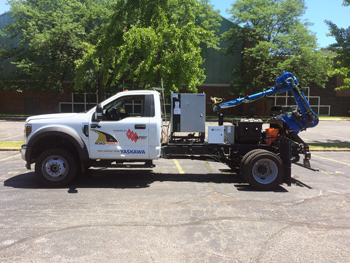Automated truck invention makes road-painting safer, faster, cheaper
A new invention by a former Cleveland Heights auto repair-shop owner and Case Western Reserve University engineering professor promises to make painting streets cheaper, faster and less risky to road workers.
Their company is called RoadPrintz Inc. Their technology is incorporated into a special truck equipped with a robotic arm. And a new licensing agreement through Case Western Reserve’s Technology Transfer Office provides the so-called university “spin-out” with exclusive rights to make, use and sell the technology or products using the technology.

Chief Executive Officer Sam Bell, a retired auto mechanic and shop owner, and Chief Technology Officer Wyatt Newman, a professor of Electrical, Computer and Systems Engineering at Case Western Reserve with an expertise in robotics, developed what is referred to as a “proof-of-concept” truck used to demonstrate the technology.
Construction of a prototype is expected to begin in February and be completed in the spring, said Bell, who spent 40 years running his Cleveland Heights auto-mechanic shop and is a contributing editor at Motor magazine.
To date, RoadPrintz has advanced the technology with a $100,000 grant from the Ohio Third Frontier Technology Validation and Start-up Fund and two Great Lakes Innovation & Development Enterprise grants totaling $100,000, along with funds from the founders.
Case Western Reserve owns the patent for certain technology relating to customized robotic road-painting systems and retains an equity stake in the company. The potential is vast.

“What really strikes me is the size of the market opportunity RoadPrintz is attacking,” said Mike Allan, senior licensing manager in the university’s Technology Transfer Office. “More than $3 billion is spent annually to paint roads in the United States. But even more impactful is how the company will improve road-worker safety. Anything that can be done to reduce the average of two deaths per day that occur because of work-zone injury crashes in the U.S. is significant.”
With its robotic arm, the RoadPrintz truck applies hot paint that dries in less than a minute, allowing the work to be done in a fraction of the time. Instead of stencils, the system uses a computer-controlled painting system analogous to a printer. The truck can paint road markings (transverse markings, diagonals, bike symbols, school-zone markings, turn arrows) for one-third the cost. And the process is safer because RoadPrintz workers don’t need to leave the truck.
For more information, contact, Bill Lubinger at william.lubinger@case.edu


